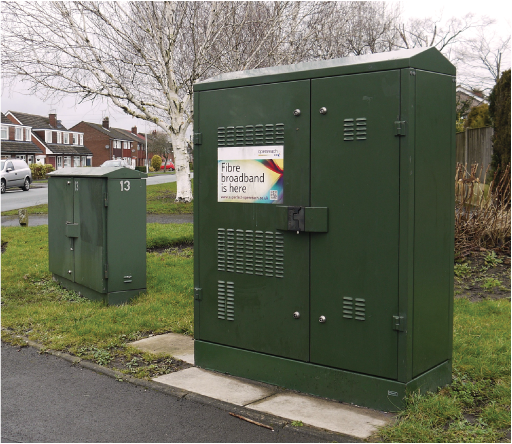4.4 VDSL2
VDSL2 (version 2 of Very High Bit Rate DSL) achieves higher data rates than ADSL by shortening the copper line. Shortening results from the use of a locally installed connection box like Figure 4.7.

The box contains, effectively, a piece of telephone-exchange equipment which is linked to the local exchange by optical fibre. Subscribers have the copper line from their home terminated at the box – at least as far as data is concerned. (Telephony continues to use copper wire to the exchange.)
Because signal attenuation per metre of copper wire increases with increasing frequency, a major benefit of a short copper line is that higher frequencies can be used and therefore more subchannels made available. VDSL2 uses many more subchannels than any version of ADSL. Various frequency plans, or profiles, are available for VDSL2. Figure 4.8 is a common one, called ‘17a’, in which the highest frequency is just above 17 MHz.
Downstream data rates with VDSL2 are typically around 30 to 80 Mbit s–1, and upstream rates can be in the region of 20 Mbit s–1, although providers often set a lower rate.
Figure 4.9 is a setting screen from a domestic VDSL2 broadband router. A range of VDSL2 profiles is shown; and because the symbol rate and subchannel width are standard across VDSL2 and ADSL the router can also cope with ADSL (as evident in the ‘Modulation’ row). ‘G.DMT’ is an informal name for the first ADSL standard, now usually referred to as ADSL1. ‘G.lite’ is a very basic form of ADSL that did not catch on. ‘SRA’ is Seamless Rate Adaptation and is one way of dynamically changing the speed of the connection according to noise conditions.


